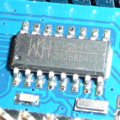Docker
Docker is similar to LXC, however it is geared to running a single application within its jailed system rather than being a lightweight VM. It's like having a chroot management system enhanced with networking.
This page details the latest version of docker for Debian bookworm. For older use cases see on docker for Debian bullseye.
Uninstall
Debian's version of docker is too old so ensure it's not installed.
apt-get remove --purge docker.io docker-compose docker-doc podman-docker containerd runc
Clean up and reboot if an old version was removed.
apt-get autoremove reboot
Install
Install using the apt repository
sudo apt-get update sudo apt-get install ca-certificates curl sudo install -m 0755 -d /etc/apt/keyrings sudo curl -fsSL https://download.docker.com/linux/debian/gpg -o /etc/apt/keyrings/docker.asc sudo chmod a+r /etc/apt/keyrings/docker.asc echo \ "deb [arch=$(dpkg --print-architecture) signed-by=/etc/apt/keyrings/docker.asc] https://download.docker.com/linux/debian \ $(. /etc/os-release && echo "$VERSION_CODENAME") stable" | \ sudo tee /etc/apt/sources.list.d/docker.list > /dev/null sudo apt-get update sudo apt-get install docker-ce docker-ce-cli containerd.io docker-buildx-plugin docker-compose-plugin
Setup
Linux post-installation steps for Docker Engine
sudo groupadd docker sudo usermod -aG docker $USER
Reboot
reboot
Test
docker --version Docker version 27.5.1, build 9f9e405
docker compose version Docker Compose version v2.32.4
ip addr show docker0
4: docker0: <NO-CARRIER,BROADCAST,MULTICAST,UP> mtu 1500 qdisc noqueue state DOWN group default
link/ether 02:42:ae:18:42:ab brd ff:ff:ff:ff:ff:ff
inet 172.17.0.1/16 brd 172.17.255.255 scope global docker0
valid_lft forever preferred_lft forever
docker run hello-world
Hello from Docker!
This message shows that your installation appears to be working correctly.
To generate this message, Docker took the following steps:
1. The Docker client contacted the Docker daemon.
2. The Docker daemon pulled the "hello-world" image from the Docker Hub.
(amd64)
3. The Docker daemon created a new container from that image which runs the
executable that produces the output you are currently reading.
4. The Docker daemon streamed that output to the Docker client, which sent it
to your terminal.
To try something more ambitious, you can run an Ubuntu container with:
$ docker run -it ubuntu bash
Share images, automate workflows, and more with a free Docker ID:
https://hub.docker.com/
For more examples and ideas, visit:
https://docs.docker.com/get-started/

